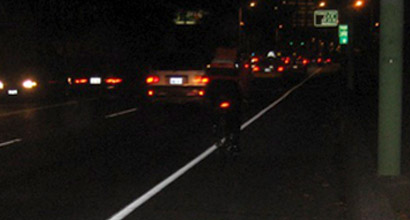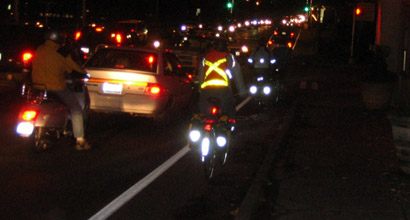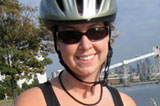bikes are quite safe, even on busy streets
- Statistics support the safety of biking compared to driving
- Lack of exercise is more likely to kill you than biking
- Bicycle accidents are caused by avoidable mistakes
- There are some simple things you can do to stay safe
biking VS driving safety
Fatal Car Crashes - Some 40,000 people are killed in the US, every year in car crashes, compared to about 700 or so on bikes. Since 1900 cars have killed more than twice as many Americans as have died in all wars in history combined.
Risky Business - Below is a table showing the results of a 1998 study by risk and failure assesors Exponent. This table shows the average fatalities per million hours for a variety of activities. As you can see, bicycling is much safer than many other common activites (and a few risky ones for comparison), including driving a passenger car, which is almost twice as dangerous, per exposure hour.
| Study Results: Exponent Consulting, 1998 | |
|---|---|
| Activity | Fatalities per Million Hrs |
| Skydiving | 128.71 |
| General Aviation | 15.58 |
| On-road Motorcycling | 8.80 |
| Scuba Diving | 1.98 |
| All Causes of Death, Average | 1.53 |
| Swimming | 1.07 |
| Snowmobiling | 0.88 |
| Passenger Cars | 0.47 |
| Bicycling | 0.26 |
Non-Fatal Car Crashes - For some reason we accept broken bones, untimely deaths, paralysis and disfigurement a worthwhile risk for the benefits of driving cars. In 1998 41,200 Americans died in car crashes and 2,200,000 lives were altered with debilitating injuries [Alvord]. If this many injuries and deaths were caused by airplanes every year, would you get on an airplane? I wouldn't.
Exercise - About 365,000 deaths per year are attributed to lack of excercise in the U.S. due to heart disease, stroke, diabetes and other conditions [citation]. I've lost about 12 pounds without even trying since I started biking to work. Fitness is worth quite a lot in terms of life quality and quantity.
Conclusion - Transportation has risks in every form. Bicycles are no more dangerous than cars. Evidence indicates that they are actually safer. At automobile speeds of 30-70 mph, what do you expect? If you really want to stay safe, consider moving closer to your place of employment and shorten the time you spend in traffic.
Visibility - A cyclist's view of the road is significantly wider and clearer than that of a driver. Driver's vision is obscured by window pillars, windsheild wipers and rainy, foggy, frosty windows. This is a huge safety advantage for cyclists. Read more on the Visibility Page.
How to be a safe bike commuter
Bike Lanes - Bike lanes are not necessarily a safe zone. Stay to their far left edge. One carelessly opened door from a parked car can send you tumbling into traffic. 30% of injury accidents can be attributed to dooring [citation]. My rule of thumb is stay at least arm's length away. More about crash types here.
Lights -
If you're riding in the dark or rain, you need lights so drivers can see you. 60% of adult bicyclist accidents come from riding in the dark without lights [citation]. A red blinker on the back and a white LED light
on the front are plenty.
Headlights - Bike shops acknowledge a difference between "safety lights" and "headlights". A headlight is much brighter, about 100 Lumens or more, which gives a cyclist the presence of a car at night, and greatly increased safety. Most headlights feature built-in rechargable batteries, and can cost anywhere from $75 - $400. More info on the Lights Page. Most of the "headlights" you buy in bike shops, in the $10-$30 range are actually just safety lights.
If you really want to make it count, get a really bright LED headlight like the Light & Motion Vega
. Think of it this way: you can see a car coming at night, even out of the corner of your eye, whether you're looking or not. Not so for most bike lights. I've seen these things in action. They will give your bike the presence of a car at night. The Vega and other re-chargable LED lights are expensive, but probably worth it.
Wear Your Helmet Properly - I think I see an exposed forehead just about every day. Push that thing forward until it sits just above your eyebrows. Imagine if your forehead hit the pavement, is it protected?
Helmets - Bicycle helmets have been proven to reduce the risk of head and brain injury when a crash occurs by as much as 85 to 88 percent.
- US National Highway Traffic Safety Administration
Reflectors - I know they look dumb during the day, but they are amazingly valuable at night. Get some reflective tape and put it on your pack, helmet and bike. You'll light up like a UFO in headlights, and if you're crafty, you can make it blend in for daylight hours so you don't look like Mr. Nerdy-Safety man. Even if you have lights, some well-placed reflectors will make you MUCH more visible in the dark. It's just like having more lights, and they don't require batteries. Can you even tell there's a cyclist in the top photo? This is what drivers see. The cyclist in the top photo has a light but no reflectors. Bottom photo show reflectors.


Ride With traffic - Riding on the wrong side of the road confuses motorists and increases your odds of causing an accident. A bicycle is a vehicle. One of my favorite bumper stickers: Same roads. Same rules. Same rights.
Bicycles are vehicles - Same roads. Same rules. Same rights.
Be Predictable - When drivers know what to expect of you, they won't run into you. Hopping curbs and weaving between lanes will not help. Using hand signals, and riding on the right side of the road will.
Hand Signals - The hand signals they taught you in driver's ed are for cars, not bikes. And half the people you ask don't even know what they mean. If you are turning left, point left with your left arm. If you are turning right, point right with your right arm. Everyone knows what that means, and that's what it's all about. And lest you think I'm some kind of rebel, this method is in fact approved per section 11-606 of the US Uniform Vehicle Code.
Sidewalks - Riding on the sidewalk is legal in some places and illegal in others. It doesn't matter. It's hazardous both ways. At best, a speeding cyclist on the sidewalk looks like a real jerk and serves only to frighten old ladies and children. Don't give the rest of us a bad name. If you must ride on a busy sidewalk, please do so very slowly (walking speed).
Don't Swerve - Looking over your left shoulder causes most people to inadvertantly swerve to the left. That's bad news when there are cars speeing by! Practice in a parking lot. Try looking over your shoulder without swerving, it's easy, you just have to think about it a little, Stiffen your left arm, move only your head. You'll get it.
Bike Crash Situations - Knowing what situations lead to a bike crash will help you avoid them like an urban ninja. Get all the info on bike crashes here.
Find more bike safety info on PartsGeek.com. Thanks for the link, Melanie.




